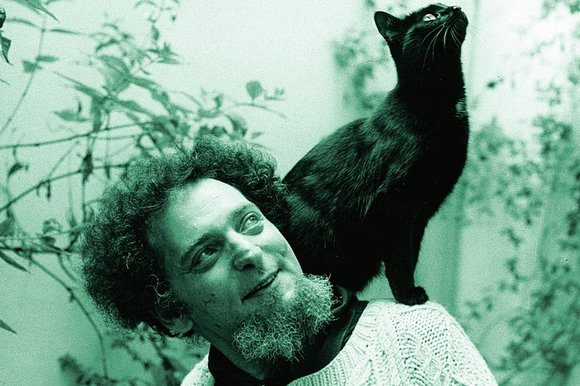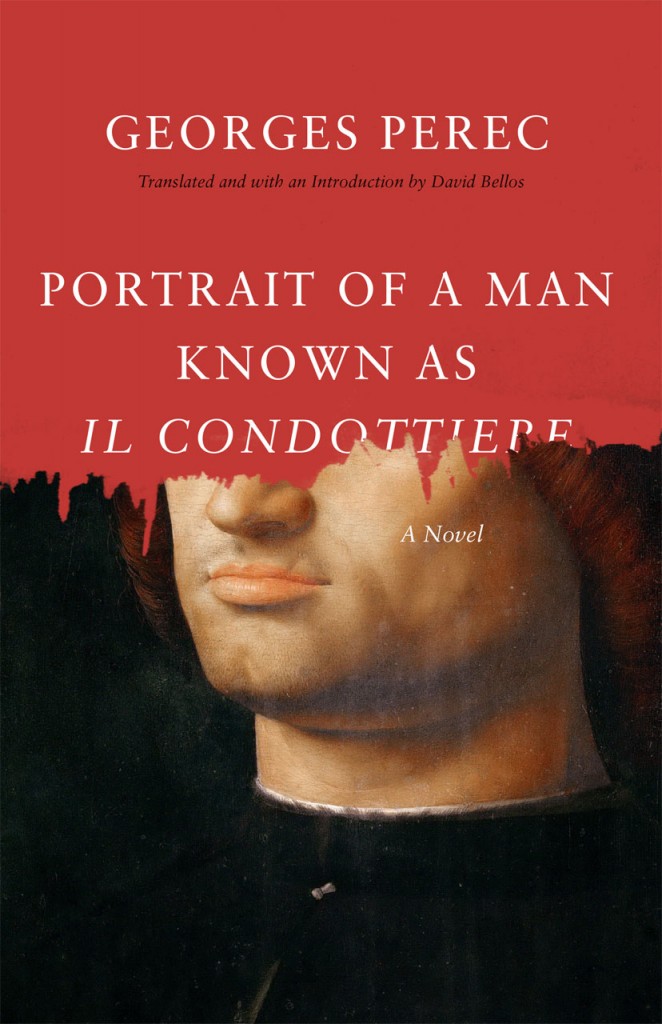Meaningless, nothingness, lack of understanding, and events sans repercussions. As translator David Bellos makes clear, this novel captures more than a taste for graphic death. It reflects a substantial debate, summed up in a work on authenticity and inauthenticity by Jean-Paul Sartre titled (in English) Anti-Semite and Jew. –Jeff Bursey
Portrait of a Man Known as Il Condottiere
Georges Perec
Trans. David Bellos
University of Chicago Press
Cloth, 144 pp., $20.00
ISBN: 9780226054254
.
1. OVER THE LAST number of years small presses have been addressing gaps in the knowledge of English-language readers when it comes to the shorter works of the acclaimed French writer Georges Perec (1936-1982), best known for his novel Life A User’s Manual (1978; translated into English in 1987), by issuing An Attempt at Exhausting a Place in Paris (2010), The Art of Asking Your Boss for a Raise (2011), La Boutique Obscure: 124 Dreams (2013), and I Remember (2014). Now we have his first novel, Portrait of a Man. In 1960 it was rewritten for the publishing house Gallimard, who had issued a contract and paid royalties ahead of receiving the completed work. According to David Bellos, when Perec finished revising it he affixed these words to the typescript: “YOU’LL HAVE TO PAY ME LOADS IF YOU WANT ME TO START IT OVER AGAIN.” Even after that effort the manuscript failed to succeed, and it gradually fell out of sight until rediscovered by Bellos while he wrote Georges Perec: A Life in Words (1993; rev. 1995). In 1960 Perec predicted that his first novel would experience one of two fates: either he would revisit it in later years and turn it into a “‘masterpiece’” or he would “‘wait in my grave until one of my faithful exegetes comes across it in an old trunk… and brings it out.’” There’s no word on if the former approach was tried, but as Bellos says, “it’s not like anything else that he wrote,” and perhaps there was no way for the Perec we are more familiar with to venture back to that earlier version of his writer self. (What goes unexplained is why it took until 2012 for the novel to appear in French.)
The plot of the book is simple. Gaspard Winckler, a forger of painters, works for a group run by the shadowy Anatole Madera. After 12 years in this occupation, preceded by four as an apprentice to Jérôme, an older forger who also works for Madera, Winckler chooses, as his next task, to create a painting supposedly by Antonella da Messina, based on the latter’s Portrait of a Man known as Il Condottiere (1475). This new work would have to come from Winckler’s soul and not be a technical exercise, yet having inhabited for years the habits and work of other painters, it is not going to be easy for him to find out who he really is. In addition to burying himself in studies of the esoteric natures of painting, wood, and visual perspectives over the ages, Winckler has been cut off from people and world events since he started his career as a posturer in 1947. What he runs into is a blunt fact: masterpieces can’t be willed into existence, and originality doesn’t emerge based on wishes. The failure of his attempt leads him—or rather, it may be one of the reasons—to rebel against his employer, and to do that he must commit an act that irrevocably cuts him off from his former life. He kills Madera, and then flees the isolated house that contained his laboratory.
Portrait of a Man is divided into two parts: the first describes Gaspard’s attempt to escape from his past; the second is comprised of a set of chapters where he tries to describe, to an inquisitive friend named Streten who is sheltering him, what he had done and why, how he entered into a lucrative career, and what propelled him out of it. Part I is filled with action and pell-mell sentences, and for a while it seems like this novel will fall into a pattern found in the “detective novels” Winckler reads now and then for mental release from the pressures of work. (This puts in mind We Always Treat Women Too Well [1947] by Raymond Queneau, written under a pseudonym, Sally Mara. Apart from being set in Dublin in the mid-1910s and using names found in James Joyce’s Ulysses, this novel ramped up, in protest and with deliberate irony, the violence and sex present in gangster novels then popular in France. Perec and Queneau were friends and members of Oulipo.) The opening lines of Portrait of a Man are startling for their pulpiness:
Madera was heavy. I grabbed him by the armpits and went backwards down the stairs to the laboratory. His feet bounced from tread to tread in a staccato rhythm that matched my own unsteady descent, thumping and banging around the narrow stairwell. Our shadows danced on the walls. Blood was still flowing, all sticky, seeping from the soaking wet towel, rapidly forming drips on the silk lapels, then disappearing into the folds of the jacket, like trails of slightly glinting snot side-racked by the slightest roughness in the fabric, sometimes accumulating into drops that fell to the floor and exploded into star-shaped stains. I let him slump at the bottom of the stairs, right next to the laboratory door, and then went back up to fetch the razor and to mop up the bloodstains before Otto returned.
On the novel’s cover a cascade of crimson obscures the top half of the Antonella painting that gives the novel its title; and that passage, with its shadows, the descent, and that dance, brings to mind the fondness the French have for murder mysteries and Edgar Allan Poe.
2.
As Bellos makes clear, this novel captures more than a taste for graphic death. It reflects a substantial debate, summed up in a work on authenticity and inauthenticity by Jean-Paul Sartre titled (in English) Anti-Semite and Jew. The figure of the forger bundles that thorny topic together with Perec’s “extensive learning” in art history, the controversy in 1945 surrounding the arrested Dutch art dealer and forger Han van Meegeren (readers of William Gaddis’ The Recognitions [1955] will recall that name and his importance in the creation of that novel), and, to my mind, looks directly at uncomfortable historical events: in the 16 years covered by Winckler’s training and output to his abrupt retirement—so, beginning in 1943—France endured, among other things, the Occupation, collaboration with Nazi Germany, the role of its citizens in sending Jews to death camps, the Resistance, and the violence of the Algerian War (1954-1962). In these atrocities, state scandals, and actions some Frenchmen led false lives. Also, during the Second World War Perec’s father was killed in battle and his mother died either in Auschwitz or on the way to it. It’s impossible to read this book, which in the second half turns into a confession-cum-self-exculpation, without wondering, in a cautious and limited way, how Winckler’s half-life symbolizes an absence within Perec (what he might have been like if his parents had lived) and within the soul of his country.
Unlike the bloody events and fevered prose of Part I, the second part is hesitant and revolves around a set of intellectual and emotional questions. Asked by Streten why he killed Madera, Winckler replies: “‘But I had to wake up one day … It didn’t matter when or where … It happened, it had to. It happened because of Mila [a girl he had some interest in], but it could have happened because of something else. It doesn’t matter.’” Further along Winckler will say: “‘My own story written down once and for all, in a closed circle, with no way out other than dying ten or twenty or thirty years on. Needing to go on to the end without meaning, without necessity …’” Streten, in his search for precise answers—he comes off as a character who has been placed in the wrong novel—pursues what he sees as a vital question:
“Why did you kill Madera?”
“I don’t know … If I knew, I wouldn’t be here … If I’d known, I suppose I wouldn’t have done it … You think it’s easy … You commit an act … You don’t know … you can’t know … you don’t want to know … But after a while it’s behind you … You know you did it … and then …”
“Then what?”
“Then nothing.”
“Why do you say ‘you’?”
“No reason … It doesn’t matter … I killed Madera … And then? It doesn’t make things any simpler … A last act, the least act of all …”
“Just to see …”
“As you say … Just to see what would happen …”
“And what did happen?”
“You can see for yourself … Nothing yet … Perhaps one day something will happen … Something worthwhile …”
Meaningless, nothingness, lack of understanding, and events sans repercussions (Bellos points out that Winckler reappears in Life A User’s Manual)—these are themes returned to, with variations, particularly in Part II. Streten insists this or that “‘doesn’t make sense,’” acutely observes that Winckler “‘pretend[s] to be a victim,’” and repeatedly demands that there be explanations for why his friend behaved as he did, which Winckler argues against: “‘You’d like there to be a solid point of departure, a sudden insight […] There wasn’t any turning point in my existence … There wasn’t a story … There wasn’t even an existence … Of course, if things had been logical […]’”
(As an aside, Perec uses ellipsis to slow the momentum of the second part of Portrait of a Man, and it’s worth noting how the same device, in the hands of Louis-Ferdinand Céline, achieves the complete opposite: in his books those three dots act like stones that trip you down an endless set of stairs at breakneck pace, leaving you breathless, dizzy, and bruised at the fall of the last line.)
Inside the “false world… a world without sense…” occupied by Winckler, where there are no narrative arcs, where he is cocooned from national and world events, where other countries exist as study locations (galleries, libraries, museums) or vacation resorts, where nothing is connected, where the insignificant and the significant weigh the same, and where fate is first invoked and then denied, the forger fitfully dreams of the possibility of a cohesive existence: “To be at long last, in your own right, the captain of your soul and the world in an irrefutable ascent, a single movement towards unity.” Winckler believes he can achieve those aims by painting a new Antonello, with its subject a man who is kin to the Condottiere—a figure who “…has nothing to lose: no friends, no enemies. He is brute force.”—yet who is sufficiently distinct so that experts will accept the forgery. How the painting turns out is not predictable (like so much else in a novel that relies on the words logical, perhaps, nothing, and so on), and the result shows Winckler what he needs to know about himself:
I looked at myself in the mirror in the middle of the night. That was me. That was my face, and my year of struggle and sleepless nights, that oak board and that steel easel, that was my face too, and so were those pots and those hundreds of brushes and the rags and the spots. My story. My fate. A fine caricature of a fate. That was me: anxious and greedy, cruel and mean, with the eyes of a rat. Looking like I thought I was a warlord.
It might be this revelation that is the impetus for the murder and the escape, but as Winckler states numerous times, it could be any reason, or simply something that just happens; even the notion of fate, shaky though it is, could be why his life went along as it did. No final justification or motive will be found, and that debate is a sizeable portion of the content. What is easier to conclude is that in this novel Perec, via Winckler, tends to explain everything (while answering little), leaving less of the pleasurable ambiguity readers might prefer. As Bellos observes: “This is a novel, not an essay. Almost.” The action of the first part is replaced by rambling talk in the second, yet nevertheless, Portrait of a Man is at times an engrossing read, with early hallmarks of the later author—a fascination with exactitude, on painting techniques and on numbers, an intellectual apparatus that undermines the structure of the novel—as well as unusual features that Georges Perec fans will want to encounter for themselves.
—Jeff Bursey
Excerpt from Portrait of a Man Known as Il Condottiere
/
/
Bellos makes clear that Perec started educating himself in visual art in the mid-1950s, and proceeded from there. He “visited exhibitions and galleries in Paris and made a trip to Berne to see a large collection of works by Paul Klee,” studied general and scholarly works and catalogues, and engaged in discussion with “Yugoslav art historians he had befriended in Paris…” Using these sources and his imaginative powers, he invested Gaspard Winckler with the language and thought processes that get across the practical, physical, and mental aspects that lie underneath the act of painting, as this extract shows.
—Jeff Bursey
The hardest part obviously was that celebrated tautness in the jaw. It was impossible to pastiche without creating a double, and there was no sense in that. In the end I settled for using Memling’s portrait as my model: a very thick and powerful neck, with the first minute signs of a double chin, very deep eyes, a line on each side of the nose and a fairly thick mouth. I would put the strength into the neck, into the articulation of the head, in the very high and straight way it was held, and in the lips. It was all fine on the drafts. On the trial paintings in gouache it even turned out rather splendidly: a complex melange of Memling and Antonello sufficiently corrected, with a very pure look in the eyes, immediate contours that yielded easily at first and then thickened, became impermeable, turning hard and merciless. No cruelty, no weakness. What I wanted. Pretty much exactly what I was after . . . It was another month before I started really painting. I had to get my pots, brushes and rags ready. I took three days’ rest. I began to paint sitting in the armchair, with my palette within easy reach, and the panel set on the easel with its four corners wrapped in cotton wool and rags so that the metal angles that held it in place would leave no mark. I had an elbow support and a crutch to keep my hand steady, a huge visor to keep the glare of the spots off my eyes, and wore magnifying goggles. An extraordinary set of safety devices. I would paint for twenty minutes and then stop for two hours. I sweated so much I had to change three or four times a day. From then on fear never left me. I don’t know why but I had no confidence at all, I never managed to have a clear vision of what I was trying to do, I couldn’t say what my panel would be like when I’d finished painting it; I wasn’t able to guarantee that it would look like any of the dozens of more or less completed drafts lying around the room. I didn’t understand some of my own details, I was unable to get a grip on the overall project, to recognise it in the smallest touch, to feel it taking shape. I was stumbling onwards, despite the innumerable safeguards I’d set up. Previously, I’d been able to paint any Renaissance picture in a couple of months, but now, after four months’ work, in mid- September, I still had the whole face to do . . .
Reprinted with permission from Portrait of a Man Known as Il Condottiere by Georges Perec. Published by the University of Chicago ©. © 2012 by Éditions du Seuil Introduction and English translation © 2015 by David Bellos. All rights reserved. Published 2015.
Jeff Bursey is a Canadian literary critic and author of the political satire Verbatim: A Novel (2010). He is a Contributing Editor at The Winnipeg Review and an Associate Editor at Lee Thompson’s Galleon. His reviews have appeared in, among others, American Book Review, Books in Canada, The Quarterly Conversation, Music & Literature, Rain Taxi, The Winnipeg Review and Review of Contemporary Fiction. He makes his home on Prince Edward Island in Canada’s Far East.
.
.



It certainly is a strange beast, this book. I was interested in your references to lurid crime novels as I hadn’t made that connection. And mirrors – it seemed to me that in getting deeper and deeper into the face he wanted to paint, he was going into a series of mirrors each containing another mirror. So getting further and further away from the masterpiece he wanted to paint and from any recognition of what he might be himself behind the face.
Nice comment on the use of mirrors, which I hadn’t seen in that way. Thanks, gertloveday.